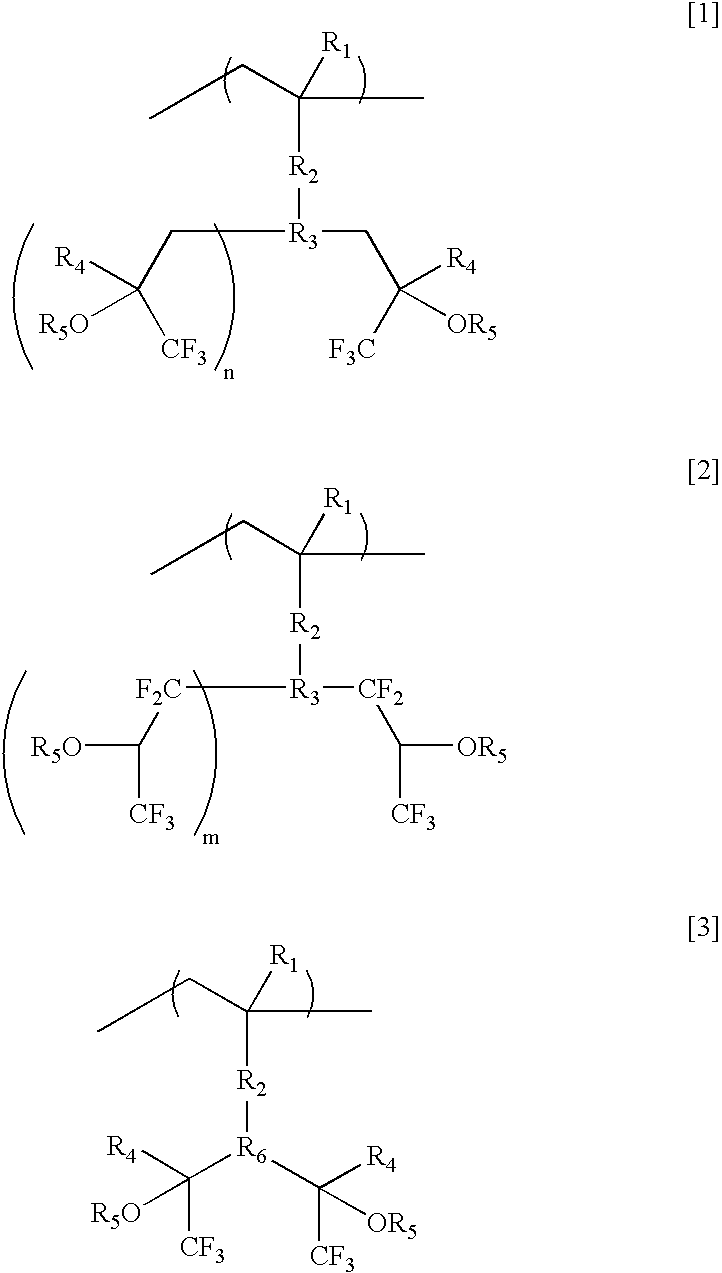Top coat composition
a composition and top coat technology, applied in the field of top coat composition, can solve the problems of not reaching the level at which the material is optimized, deficient in solubility in developing solution, etc., and achieve the effect of suppressing swelling and dissolution
- Summary
- Abstract
- Description
- Claims
- Application Information
AI Technical Summary
Benefits of technology
Problems solved by technology
Method used
Image
Examples
example 1
Synthesis of Polymer Compound (2)
[0057]
[0058] A 500 ml round-bottom flask equipped with a reflux condenser and a stirrer was charged with the compound (1) (50 g), azobisbutyronitrile (AIBN) (0.8 g), n-dodecylmercaptane (1.0 g), and methyl ethyl ketone (200 ml), followed by replacing the flask interior with nitrogen. This was heated in an oil bath of 75° C., and stirring was conducted for 18 hr. After the end of the reaction, the reaction solution was added to n-hexane (1,600 ml), followed by stirring. The resulting precipitate was filtered and taken out. This was dried at 50° C. for 20 hr, thereby obtaining the polymer compound (2) (22 g) of a white color solid. The molecular weight was determined by GPC (standard polystyrene). The polymerization reaction is shown in Table 1, and its results are shown in Table 2.
example 2
Synthesis of Polymer Compound (4)
[0059]
[0060] Similar to the method described in Example 1, a copolymerization reaction of the compound (1) and the compound (3) was conducted, thereby obtaining the polymer compound (4). The polymerization reaction is shown in Table 1. The obtained polymer compound is shown in Table 2.
example 3
Synthesis of Polymer Compound (7)
[0061]
[0062] Similar to the method described in Example 1, a copolymerization reaction of the compound (5) and the compound (6) was conducted, thereby obtaining the polymer compound (7). The polymerization reaction is shown in Table 1. The obtained polymer compound is shown in Table 2.
PUM
| Property | Measurement | Unit |
|---|---|---|
| Fraction | aaaaa | aaaaa |
| Fraction | aaaaa | aaaaa |
| Fraction | aaaaa | aaaaa |
Abstract
Description
Claims
Application Information
 Login to View More
Login to View More - R&D
- Intellectual Property
- Life Sciences
- Materials
- Tech Scout
- Unparalleled Data Quality
- Higher Quality Content
- 60% Fewer Hallucinations
Browse by: Latest US Patents, China's latest patents, Technical Efficacy Thesaurus, Application Domain, Technology Topic, Popular Technical Reports.
© 2025 PatSnap. All rights reserved.Legal|Privacy policy|Modern Slavery Act Transparency Statement|Sitemap|About US| Contact US: help@patsnap.com



